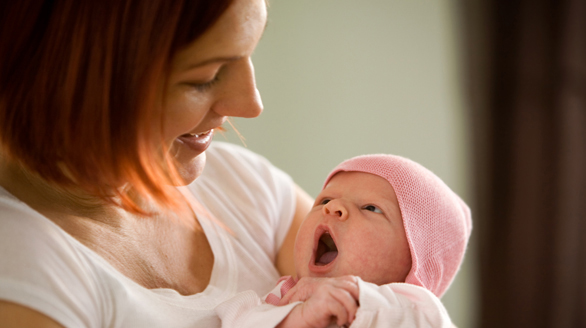Nine years ago, Miki Clark Narva, then 36, wanted a baby. She had climbed the ranks in the sales department at the software technology company where she worked. She had traveled through Europe, Africa, and New Zealand with her husband, Ashton, whom she met at the office when she was 29 and married when she was 34. She had succeeded at everything she’d set her mind to doing, and yet, she couldn’t get pregnant.
“I don’t mean to sound arrogant, but I was used to things just working out,” says Narva, now 45. “I was of the mindset that you try hard, and if it doesn’t work, you try harder.”
So she did just that. After six months of baby-making attempts on their own, the Narvas scheduled an appointment with a fertility specialist to discuss their options, and they immediately started trying various routes to conception. “Ashton and I went through all the tests to make sure everything was working properly, and then we started the process of ovulation-boosting drugs, followed by artificial insemination attempts.” When they still weren’t pregnant after a year, Narva says she felt more annoyed than sad. “I was so accustomed to success, I remember thinking, ‘Where the heck is this baby?’”
Their last resort was in vitro fertilization (IVF), often considered the trump card of fertility treatments despite the fact that the likelihood of delivering a healthy baby thanks to IVF isn’t as great as Halle Berry and Angelina Jolie would have you believe. According to the American Pregnancy Association, the live-birth rate for women ages 35 to 37 who’ve undergone IVF is 25 percent; that success rate goes down to 15 to 20 percent in women ages 38 to 40 and to a mere 6 to 10 percent in women over 40.
A month before her 38th birthday, Narva was on the lucky end of those statistics and got pregnant with twins. Despite the struggles she faced getting pregnant and the tough pregnancy she experienced carrying her twin boys, the Morrison, Colo., mom says if she could do it again, she wouldn’t have tried to start a family when she was younger.
“I had such a cool, rich life before I had my boys,” she says. “I think the fact that I had all of those experiences makes me a better mom now.”
Narva is one of many women waiting until their late 30s and 40s to start a family. According to the National Center for Health Statistics, the number of babies born to women ages 35 to 39 rose 52 percent between 1990 and 2005. The data also shows that birth rates are at their highest point among women ages 40 to 44 since 1967. In fact, the trend even seems to be recession proof: The Centers for Disease Control and Prevention reported that while there was an overall decline in 2007 to 2009, births to women age 40 to 44 were actually up 6 percent.
While these numbers are making doctors take notice, they’re not particularly surprising, says Althea O’Shaughnessy, M.D., an obstetrician, gynecologist, and reproductive endocrinologist at the Princeton Center for Reproductive Medicine in Pennington, N.J. “Women are going to college in record numbers, they’re focusing on their careers, and they’re getting married later,” says O’Shaughnessy. “It’s no surprise that women are waiting to become moms.”
Elizabeth Gregory, a professor at the University of Houston and author of Ready: Why Women Are Embracing the New Later Motherhood, puts it even more simply: “The basic reason women are waiting to have their first baby is because they can,” she says.
Want Baby, Will Wait
Gregory’s explanation is actually more complex than it sounds, considering there are a number of reasons why it’s now more physically possible and socially acceptable for a woman to wait until her late 30s or 40s to have her first child.
For starters, women are outpacing men in college enrollment by a ratio of 1.4 to 1. And we’re not just going to school to meet a nice husband worthy of mixing our DNA. More women are entering and staying in the workforce than ever before, and taking a break to have a baby or two when you’re on an upward trajectory at work doesn’t exactly do wonders for your career—or your paycheck.
“Women are recognizing that you make a lot more money if you delay parenthood,” says Gregory. How much more can a woman expect to bank if she spends her 20s pulling long hours at the office instead of pushing a double stroller? University of Virginia economist Amalia Miller calculated that for every year a college grad delays having a baby, she makes 9 percent more annually in earnings. (How’d she do that math? By combining an average wage increase of 3 percent each year with an average 6 percent increase in hours worked.) That means you’ll nearly double your income if you delay having a baby for a decade after your college graduation.
This focus on work has also led to women delaying marriage. Today, the average woman is 27 when she ties the knot; in 1990, she was 23. And if a 20-something’s main focus used to be starting a family and creating a home, these days it’s often all about spending extra income on fun and travel. “Almost all of the women I spoke to for my book told me that part of the reason they delayed motherhood was because they wanted to go out and climb a mountain, see new places, and do everything they wanted to do before they became parents,” says Gregory. Beth Magin, a 39-year-old website producer, can relate. She met her husband when she was 33, and getting pregnant wasn’t even on her radar at that time.
“I always knew I wanted kids—I’d say I wanted kids more than I even wanted to be married—but there were so many things I wanted to do before starting a family,” says Magin. “I wanted to travel and live abroad. I wanted to have fun and experience the world a little.” Magin and her husband, Kim, moved to London and traveled extensively to scuba dive—a hobby they share. When they moved to Los Angeles three years later and started trying for a baby, Magin, then 36, didn’t get pregnant right away. “After almost two years of trying everything from acupuncture to fertility drugs and dealing with the stress that comes along with all of that, I resolved that a doctor was going to have to help us have a baby,” says Magin, who got pregnant after one cycle of artificial insemination when she was 38 years old and is due in January.
While Gregory says the couples she interviewed didn’t wait to have a baby just because they knew they could use fertility treatments, many did think of advances in the field of fertility medicine as a reassurance. “I think people find comfort in the fact that fertility treatments can be a helpful backup if they’re not already in a relationship or in a situation where they feel ready for a baby by the time they should be trying,” says Gregory. And doctors—even the fertility specialists who help women in their late 30s and 40s have babies—say the ideal time for a woman to get pregnant is before age 35.
“I told my daughters that if you get to be 30 and you don’t have babies, look around and say, ‘It’s time,’” says Richard J. Paulson, M.D., chief of the division of reproductive endocrinology and infertility at the University of Southern California. “I said to them, ‘If you’re not going to have babies between 30 and 35, freeze your eggs.’”
So Many Options, So Much (More) Time
The physiology is undeniable: A woman’s fertility declines with every birthday. Women are born with a finite number of eggs, and those eggs are at their peak when a woman is at 20 weeks of pregnancy in her mother’s womb. They decline in number—and quality—from there.
“We have every indication that it becomes more difficult to get pregnant as a woman gets older, and we know that most of this has to do with the aging of a woman’s eggs,” says Paulson. “The reality is that the egg plays a huge role in the course of reproduction. Even though the egg and sperm have to come together, the egg does 99.9 percent of the work, controlling everything from the lining up of chromosomes to the implantation in the uterus,” says Paulson. Translation: The older your eggs, the greater your chances of problems getting and staying pregnant.
Enter fertility treatments, which are helping a growing number of women over 35 realize their dream of having a baby. The use of fertility treatments has doubled in the past decade, and according to the Society for Assisted Reproductive Technologies, attempts at IVF rose by half among women 41 and older between 2003 and 2011. While the options are largely the same as they were when fertility treatments started to become available in the 1980s, advances in the field have meant more women are using them—and having better outcomes.
“Science continues to move along and the success rates are improving,” says Paulson. “And we’re starting to see a lot of advances that are helping women give birth to one healthy baby instead of multiples.” For example, genetic analysis of the embryo has come a long way, thanks to better DNA technology, which means doctors are able to transfer fewer embryos. Multiple birth rates, which are riskier than one-baby pregnancies, are decreasing as a result. Egg cryopreservation (or freezing) has also drastically improved, making it possible for women who are delaying motherhood to get pregnant with their own, frozen-in-time younger eggs later on.
Amy Lappen, a 40-year-old mom of 11-month-old twins, benefited from these advances in the field of fertility medicine. Lappen, who had an eye for “sexy artists and philosophizing wanderers” when she was in her 20s, met her husband when she was 34 and got married when she was 36. “Everything was working out according to plan,” she says. “I always thought a great time to get married would be in my mid-30s, and then I’d have a couple kids around 40,” she says. But when she wasn’t getting pregnant after a year of trying—and fertility tests showed Lappen’s number of eggs and hormone levels weren’t great—she opted for IVF.
“We also chose to do chromosomal testing, so we could take a closer look at the embryos to see if they were viable or had any issues,” says Lappen. “Out of all of the eggs the doctors fertilized, only two made it through that process. Those were the two they transferred and became my sons, Jackson and Lewis.”
If there’s a deterrent to using fertility treatments—particularly IVF, embryo chromosomal testing, and egg cryopreservation and donation—it’s cost. While some states are doing better than others in mandating insurance coverage for infertility, we’ve got a long way to go, says Barbara Collura, the executive director and CEO of RESOLVE, a national infertility association based in Washington, DC. “In terms of public awareness of infertility, we’ve made strides—there’s less stigma, and women who are going through it feel less alone,” she says. “But when it comes to access to fertility treatments, there has been very little progress.”
Currently, 15 states require some insurance coverage of fertility treatments, but laws on how much coverage—and which treatments are covered—vary widely. For example, in New Jersey, group insurers and HMOs that provide pregnancy-related coverage must provide infertility treatment, including diagnostic testing, artificial insemination, and even IVF; California, Louisiana, and New York have laws that require coverage of infertility treatments, but IVF is excluded. (For a list of states that mandate insurance for fertility treatments, as well as details on coverage, visit resolve.org.)
Narva says she was lucky: IVF was covered under her husband’s insurance policy, and they spent less than $500 total on fertility treatments. Michelle Bornstein, a 38-year-old single mother by choice who has a 2-year-old daughter and is expecting twins in January, says she wishes she had that kind of insurance policy. The Kentucky native estimates she’s spent about $30,000 getting pregnant, $10,000 of which she had to borrow from her parents. “The money piece was stressful,” says Bornstein. “It’s wonderful to have so many options, but it’s a shame that those options are cost prohibitive for so many women.”
The Realities of Midlife Mommyhood
Not only does it cost more money for many women to have a baby after 35, but it’s also important to keep in mind that those fertility treatments aren’t guaranteed to work. While IVF may seem like a magic bullet for the 35-and-up set—everyone knows someone who had a baby thanks to IVF, and then there’s the posse of 40-something A-listers who seem to have no problem getting pregnant—the statistics aren’t that great. While success rates vary due to different treatment approaches at fertility clinics around the country, according to the American Pregnancy Association, the fact is that a 35-year-old has only about a 1 in 3 chance of getting pregnant and delivering a baby through IVF. For a 40-year-old, those chances drop to 1 in 10.
“Unfortunately, when a woman reaches a certain age, there’s very little physicians can do to help her have a baby,” says O’Shaughnessy. “We can tell a woman in her 40s to go straight to IVF, but in terms of bettering her prognosis, we can’t do that.”
This leads to a lot of women wishing they had started trying to have a family earlier—even women like Katie Worden, who’s a fertility treatment success story. At 38, she gave birth to her daughter, Alexis, after one round of IVF. Worden and her husband, Neil, wanted Alexis to have a sibling, so they cashed in their IRAs and even borrowed money from their parents to go through two more rounds of IVF. On the first try, Worden was 39; she was 40 when they went in for their last attempt, at which point the doctor said the next step would be an egg donor.
“The bottom line is that my eggs were too old,” says Worden, now 45. “When the IVF didn’t work on those last two tries, I was completely depressed. I hugged my daughter and was so thankful we had her, but I felt guilty because it took me so long to meet the right guy. I still get sad about not being able to give Lexi a sibling.”
Even when fertility treatments are successful, advanced maternal age also means a greater risk of health issues during pregnancy, as both Narva and Lappen know too well. When Narva was pregnant with her boys, she was on bedrest for five months due to placenta previa, a condition where the baby’s placenta covers the mother’s cervix, causing severe bleeding before or during labor. Lappen ended up hospitalized in the intensive care unit due to pre-eclampsia, a condition marked by high blood pressure and a high level of protein in the urine that can lead to premature labor and, in worst-case scenarios, the death of both mom and baby. Both of these conditions may have been related to Narva and Lappen’s age, as well as the fact that they were carrying twins due to IVF, says Paulson.
But having babies later in life does have its benefits. Studies show older parents are more confident and less stressed. They’re also often happier than their own parents were.
“What I derived after talking to so many women who’d delayed motherhood is that being able to leave a marriage makes it more likely that you won’t want to,” says Gregory. “There’s an entire generation of women who saw their moms stuck in marriages because they had to stay—they couldn’t earn a living on their own.”
Adding to this feeling of freedom is the fact that our partners are more established as well, both financially and in their commitment to being fathers. “When dads are older, they’ve already done a lot in their lives and want to be home with the kids in a way they may not have wanted earlier on,” says Gregory. “That’s leading to happier moms as well, because there’s a shared parenting experience.”
Research proves that kids may be better off as well. Studies show children with older parents do better on reading and math tests; one study published last year even found that kids are less prone to injuries or emotional troubles when their mothers are older. The study authors say this may be due to socio-economic factors: Kids with older parents often grow up in households with a higher income, meaning there’s more money to spend on everything from extra-curricular activities to therapy.
Narva says she’s proof that delaying motherhood can be a boon. “The twins are thriving, and I’m not only happier but I’m also more fit than I’ve been since high school,” she says. “I’m not messing around. I’ve got to keep up with two super-active boys—I’m not going to be some granny sitting in the corner.”










